1998 HONDA CIVIC COUPE engine overheat
[x] Cancel search: engine overheatPage 124 of 251
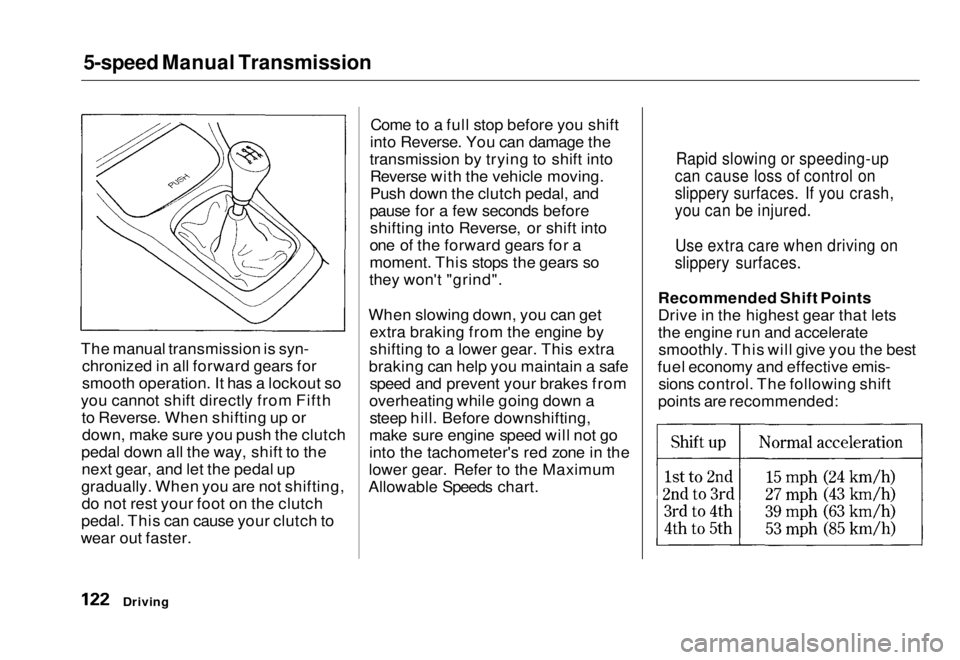
5-speed Manual Transmission
The manual transmission is syn- chronized in all forward gears for
smooth operation. It has a lockout so
you cannot shift directly from Fifth to Reverse. When shifting up ordown, make sure you push the clutch
pedal down all the way, shift to the next gear, and let the pedal up
gradually. When you are not shifting, do not rest your foot on the clutch
pedal. This can cause your clutch to
wear out faster. Come to a full stop before you shift
into Reverse. You can damage the
transmission by trying to shift into Reverse with the vehicle moving.
Push down the clutch pedal, and
pause for a few seconds before shifting into Reverse, or shift into
one of the forward gears for a
moment. This stops the gears so
they won't "grind".
When slowing down, you can get extra braking from the engine by
shifting to a lower gear. This extra
braking can help you maintain a safe speed and prevent your brakes from
overheating while going down a steep hill. Before downshifting,
make sure engine speed will not go
into the tachometer's red zone in the
lower gear. Refer to the Maximum
Allowable Speeds chart. Recommended Shift Points
Drive in the highest gear that lets
the engine run and accelerate
smoothly. This will give you the best
fuel economy and effective emis- sions control. The following shift
points are recommended:
Driving
Rapid slowing or speeding-up
can cause loss of control on
slippery surfaces. If you crash,
you can be injured.
Use extra care when driving on
slippery surfaces.Main Menu Table of Contents s t
Page 173 of 251
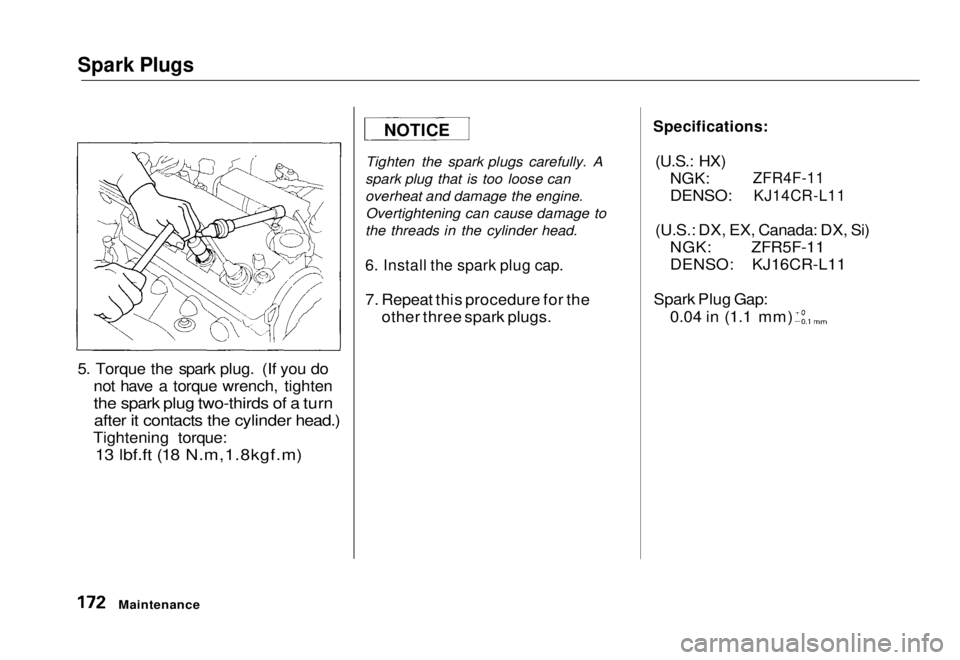
Spark Plugs
5. Torque the spark plug. (If you do
not have a torque wrench, tighten
the spark plug two-thirds of a turn
after it contacts the cylinder head.)
Tightening torque:
13 lbf.ft (18 N.m,1.8kgf.m)
Tighten the spark plugs carefully. A
spark plug that is too loose can
overheat and damage the engine. Overtightening can cause damage to
the threads in the cylinder head.
6. Install the spark plug cap.
7. Repeat this procedure for the other three spark plugs.
Specifications:
(U.S.: HX) NGK:
DENSO:
ZFR4F-11
KJ14CR-L11
(U.S.: DX, EX, Canada: DX, Si) NGK: ZFR5F-11
DENSO: KJ16CR-L11
Spark Plug Gap: 0.04 in (1.1 mm)
Maintenance
NOTICEMain Menu Table of Contents s t
Page 205 of 251
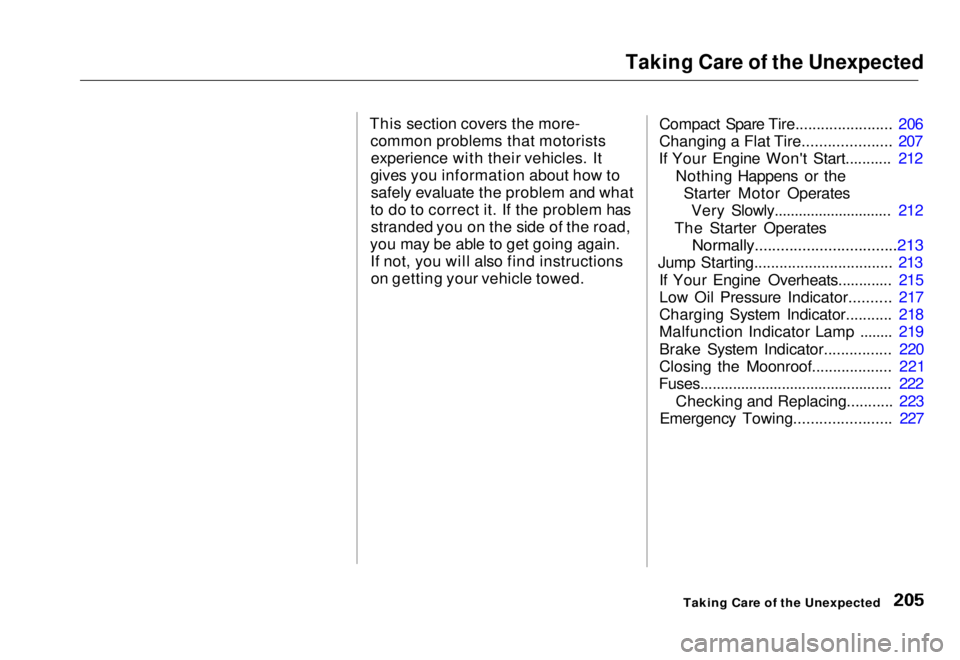
Taking Care of the Unexpected
This section covers the more- common problems that motoristsexperience with their vehicles. It
gives you information about how to safely evaluate the problem and what
to do to correct it. If the problem has stranded you on the side of the road,
you may be able to get going again. If not, you will also find instructionson getting your vehicle towed. Compact Spare Tire....................... 206
Changing a Flat Tire..................... 207
If Your Engine Won't Start........... 212
Nothing Happens or theStarter Motor OperatesVery Slowly............................. 212
The Starter Operates
Normally.................................213
Jump Starting................................. 213
If Your Engine Overheats............. 215
Low Oil Pressure Indicator.......... 217
Charging System Indicator........... 218
Malfunction Indicator Lamp ........ 219
Brake System Indicator................ 220
Closing the Moonroof................... 221
Fuses............................................... 222
Checking and Replacing........... 223
Emergency Towing....................... 227
Taking Care of the UnexpectedMain Menu s t
Page 215 of 251
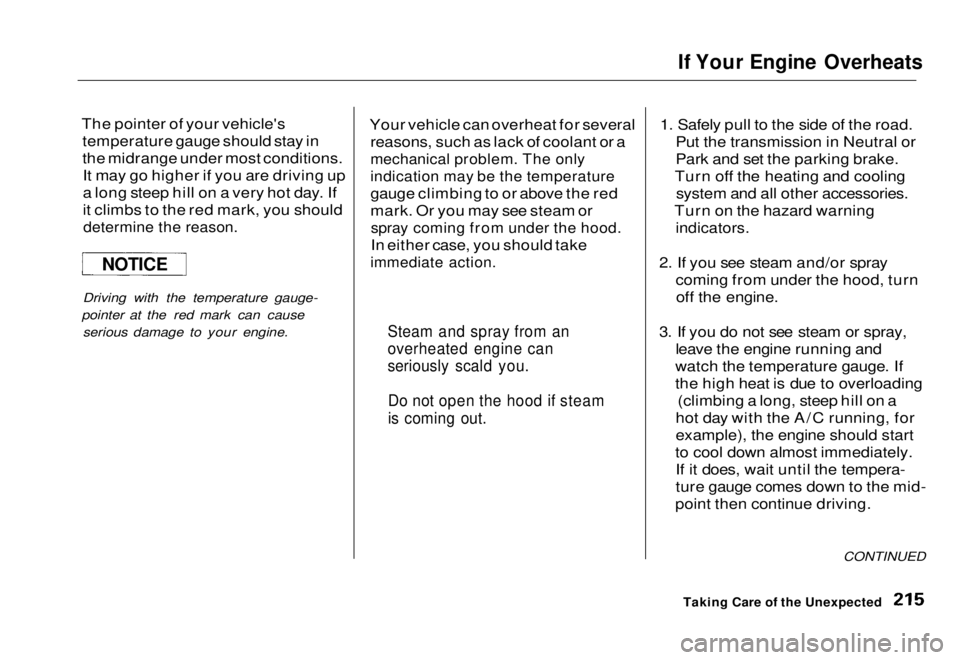
If Your Engine Overheats
The pointer of your vehicle's temperature gauge should stay in
the midrange under most conditions.It may go higher if you are driving up
a long steep hill on a very hot day. If
it climbs to the red mark, you should
determine the reason.
Driving with the temperature gauge-
pointer at the red mark can cause serious damage to your engine. Your vehicle can overheat for several
reasons, such as lack of coolant or a
mechanical problem. The only
indication may be the temperature
gauge climbing to or above the red
mark. Or you may see steam or
spray coming from under the hood.
In either case, you should take
immediate action.
1. Safely pull to the side of the road.
Put the transmission in Neutral or
Park and set the parking brake.
Turn off the heating and cooling system and all other accessories.
Turn on the hazard warning
indicators.
2. If you see steam and/or spray coming from under the hood, turnoff the engine.
3. If you do not see steam or spray, leave the engine running and
watch the temperature gauge. If
the high heat is due to overloading (climbing a long, steep hill on a
hot day with the A/C running, for
example), the engine should start
to cool down almost immediately. If it does, wait until the tempera-
ture gauge comes down to the mid-
point then continue driving.
CONTINUED
Taking Care of the Unexpected
NOTICE
Steam and spray from an
overheated engine can
seriously scald you.Do not open the hood if steam
is coming out.Main Menu Table of Contents s t
Page 216 of 251
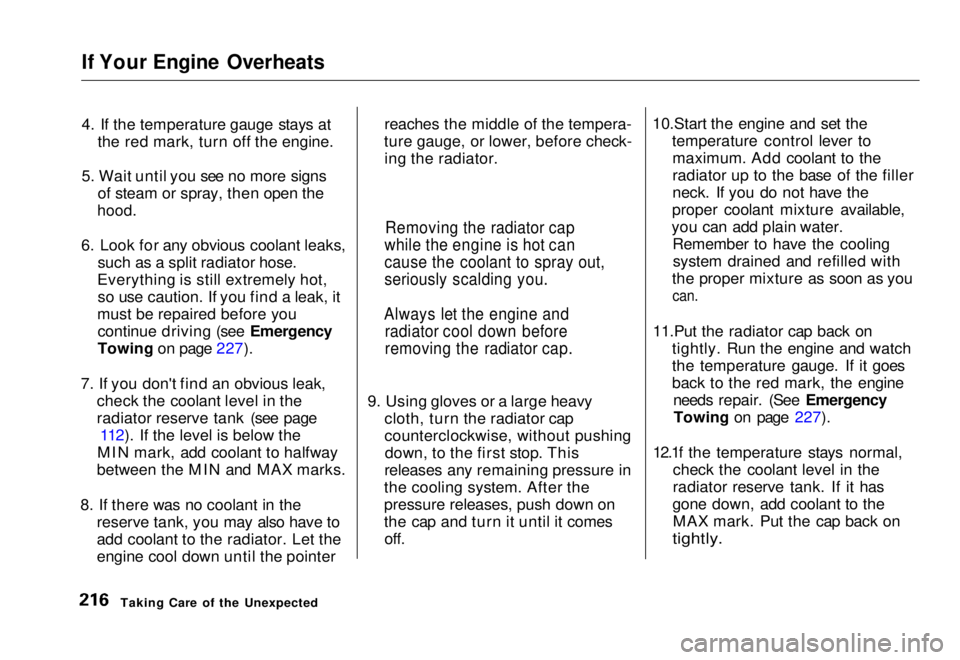
If Your Engine Overheats
4. If the temperature gauge stays at
the red mark, turn off the engine.
5. Wait until you see no more signs of steam or spray, then open the
hood.
6. Look for any obvious coolant leaks, such as a split radiator hose.
Everything is still extremely hot, so use caution. If you find a leak, it
must be repaired before you continue driving (see Emergency
Towing on page 227).
7. If you don't find an obvious leak, check the coolant level in the
radiator reserve tank (see page112). If the level is below the
MIN mark, add coolant to halfway
between the MIN and MAX marks.
8. If there was no coolant in the reserve tank, you may also have to
add coolant to the radiator. Let the
engine cool down until the pointer reaches the middle of the tempera-
ture gauge, or lower, before check- ing the radiator.
9. Using gloves or a large heavy cloth, turn the radiator cap
counterclockwise, without pushingdown, to the first stop. This
releases any remaining pressure in
the cooling system. After the
pressure releases, push down on
the cap and turn it until it comes off. 10.Start the engine and set the
temperature control lever tomaximum. Add coolant to the
radiator up to the base of the filler
neck. If you do not have the
proper coolant mixture available,
you can add plain water. Remember to have the coolingsystem drained and refilled with
the proper mixture as soon as you
can.
11.Put the radiator cap back on tightly. Run the engine and watch
the temperature gauge. If it goes
back to the red mark, the engineneeds repair. (See EmergencyTowing on page 227).
12.1f the temperature stays normal, check the coolant level in the
radiator reserve tank. If it has
gone down, add coolant to the MAX mark. Put the cap back on
tightly.
Taking Care of the Unexpected
Removing the radiator cap
while the engine is hot can
cause the coolant to spray out,
seriously scalding you.
Always let the engine and radiator cool down before
removing the radiator cap.Main Menu Table of Contents s t
Page 249 of 251
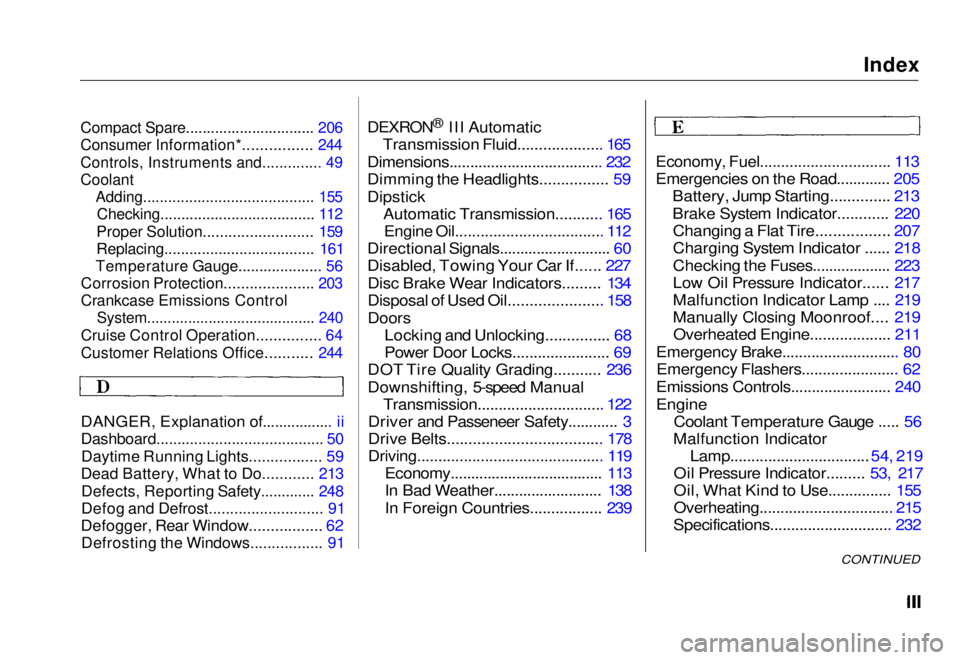
Index
Compact Spare............................... 206
Consumer Information*................ 244
Controls, Instruments and.............. 49
Coolant
Adding......................................... 155
Checking..................................... 112
Proper Solution.......................... 159
Replacing.................................... 161
Temperature Gauge.................... 56
Corrosion Protection..................... 203
Crankcase Emissions Control
System......................................... 240
Cruise Control Operation............... 64
Customer Relations Office........... 244
DANGER, Explanation of................. ii
Dashboard........................................ 50
Daytime Running Lights................. 59
Dead Battery, What to Do............ 213
Defects, Reporting Safety............. 248
Defog and Defrost........................... 91
Defogger, Rear Window................. 62
Defrosting the Windows................. 91
DEXRON
®
III Automatic
Transmission Fluid.................... 165
Dimensions..................................... 232
Dimming the Headlights................ 59
Dipstick Automatic Transmission........... 165
Engine Oil................................... 112
Directional Signals........................... 60
Disabled, Towing Your Car If...... 227
Disc Brake Wear Indicators......... 134
Disposal of Used Oil...................... 158
Doors
Locking and Unlocking............... 68
Power Door Locks....................... 69
DOT Tire Quality Grading........... 236
Downshifting, 5-speed Manual Transmission.............................. 122
Driver and Passeneer Safety............ 3
Drive Belts.................................... 178
Driving............................................ 119
Economy..................................... 113
In Bad Weather.......................... 138
In Foreign Countries................. 239
Economy, Fuel............................... 113
Emergencies on the Road............. 205
Battery, Jump Starting.............. 213
Brake System Indicator............ 220Changing a Flat Tire................. 207
Charging System Indicator ...... 218
Checking the Fuses................... 223
Low Oil Pressure Indicator...... 217
Malfunction Indicator Lamp .... 219
Manually Closing Moonroof.... 219Overheated Engine................... 211
Emergency Brake............................ 80 Emergency Flashers....................... 62
Emissions Controls........................ 240
Engine
Coolant Temperature Gauge ..... 56
Malfunction Indicator
Lamp.................................
54, 219
Oil Pressur e
Indicator......... 53,
217
Oil, Wha
t
Kind to Use............... 155
Overheating................................ 215
Specifications............................. 232
CONTINUEDMain Menu s t